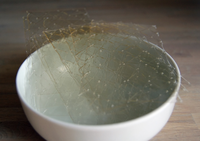
Photo from wikipedia
The growing environmental concern over petrochemical-based plastics continuously promotes the exploration of green and sustainable substitute materials. Compared with petrochemical products, cellulose has overwhelming superiority in terms of availability, cost,… Click to show full abstract
The growing environmental concern over petrochemical-based plastics continuously promotes the exploration of green and sustainable substitute materials. Compared with petrochemical products, cellulose has overwhelming superiority in terms of availability, cost, and biodegradability; however, cellulose's dense hydrogen-bonding network and highly ordered crystalline structure make it hard to be thermoformed. A strategy to realize the partial disassociation of hydrogen bonds in cellulose and the reassembly of cellulose chains via constructing a dynamic covalent network, thereby endowing cellulose with thermal processability as indicated by the observation of a moderate glass transition temperature (Tg = 240 °C), is proposed. Moreover, the cellulosic bioplastic delivers a high tensile strength of 67 MPa, as well as excellent moisture and solvent resistance, good recyclability, and biodegradability in nature. With these advantageous features, the developed cellulosic bioplastic represents a promising alternative to traditional plastics.
Journal Title: Advanced materials
Year Published: 2023
Link to full text (if available)
Share on Social Media: Sign Up to like & get
recommendations!